Steel Toilet
Steel Diver Review
|
|
See PixlBit's Review Policies

On 03/29/2011 at 07:22 AM by Nick DiMola A DS tech demo surprisingly doesn't make for very compelling 3DS launch game. |

For simulation fans only. Even then, given the light content, wait for a price drop or rent it instead.
There's no question, Steel Diver is a weird game. Even after playing it for a while, I'm still not totally sure how to feel about it. Clearly, it's not the deepest of games and it's definitely not one of the better launch titles available, especially from Nintendo. Furthermore, its 2D gameplay does a better job showcasing the touch screen than it does the 3D effect; which isn't totally surprising considering the game started as a DS tech demo. The gimmicky Periscope mode handles that just fine, but like the main content, it's not going to be compelling for the majority of players.
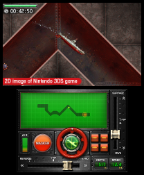
At its core, Steel Diver is something of a submarine simulation. There are three subs in the game, each of which acts indirectly as a difficulty setting. The smallest sub is the easiest to navigate, sporting the least controls, while the largest is the most cumbersome to pilot, both due to its size and additional controls. To navigate any given 2D level, players must control the depth and speed of the sub in order to avoid rock structures and the ocean floor, as well as environmental effects that occur at triggered points in certain levels. Each sub also has the ability to fire missiles which must be used to destroy impediments such as enemy ships, incoming missiles, rocks and barriers, as well as some of the specific environmental objects that are triggered.
In the smallest sub, this is typically pretty simple as you don't have to worry about much other than depth and speed. With the largest sub, things become far more complicated as you need to constantly adjust the pitch of your sub in order to navigate tighter areas and aim precisely at enemy vessels. Control is completely handled by the touch screen, with depth and speed controlled by a vertical and horizontal slider respectively. Pitch is handled with a valve that must be turned according to the angle you want your vessel to point. Missiles are fired by tapping the proper touch screen button as well.
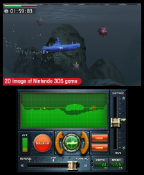
If this entire set up sounds awkward, that's because it is – and intentionally so. It's seemingly meant to mimic control of a real submarine, or at least provide something more realistic than an accelerator, brake, and steering device as seen in most submarine inspired games/mini-games. Given its awkwardness, the entire experience is fairly challenging, but the game doesn't require much more than reaching the finish line to complete a level.
A hefty health bar that can be refilled by surfacing also helps in making things a bit more approachable, but even with the generous amount of life, later missions become insanely tough, requiring players to master the controls and the events and enemy locations in the level. In this regard, the game is quite congruent with one of Nintendo's other launch titles, Pilotwings Resort. Both are strongly focused on perfecting skills and replaying missions for high scores. The exception here is that scores don't exist and instead players must shoot for the fastest level completion time, making for an experience that feels even more stripped down than the aforementioned Pilotwings.
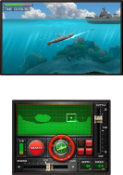
Upon completing any given level, players are given control of the periscope and must spin in the real world to direct missiles and destroy the enemy vessels surrounding your own. It’s mildly entertaining the first time around, but is so similar and devoid of challenge each recurring time, it quickly wears thin. Subsequently, this event feels tacked on to the 2D core experience of the Mission mode.
This short 30-second adjunct to each mission is expanded upon in the game's Periscope Strike mode. Here, the game gives players the ability to choose from a few different scenarios and proceeds in providing a 360 degree viewpoint, thanks to the gyroscopes, to shoot missiles at enemy ships. Players can avoid incoming fire by diving and zoom in on enemies by moving levers on the touch screen. It's a simplistic mode that provides nothing more than a cheap thrill for a few missions. It too is focused on completion times, providing very little to come back to for the dedicated player.
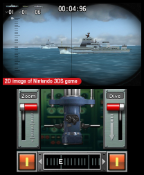
One other mode is offered, a one-on-one multiplayer strategy game that's fairly uninteresting to play, whether it be against the computer or a human opponent. Essentially a version of Battleship, players will locate opposing vessels in a top-down view and enter Periscope mode to defeat them.
The graphical presentation does have a certain amount of charm to it, with everything having a slightly cartoon-like vibe. This combined with the 3D makes for pleasing visuals, but ones that don't make very effective use of the 3D effect. Periscope mode doesn't look quite as good, but is passable.
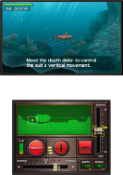
While I can see the appeal of Steel Diver for some, it's not really a game for me. More often than not, I found navigating the subs to be stressful. Believe it or not, even in the simplest of levels, each and every sub required unbelievable amounts of tinkering to make it go exactly where I intended. This isn't a knock on the game's controls, as they work completely fine – they are just extremely tough to master and require an amount of vigilance I don't care to exert.
Steel Diver is a unique game, but one that won't likely appeal to a wide variety of players. Those who like simulation style games will likely connect with Steel Diver. It clearly has replay value; however, the mission count is pathetically low, which may dissuade even those who do have an interest in it. Worse, the final two missions are locked, requiring players to complete all five preceding missions with all three submarines to unlock them. Put this all together and Steel Diver isn't a very compelling purchase, especially for those looking for launch window software.







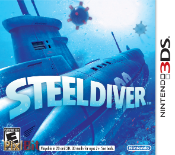

Comments